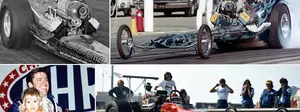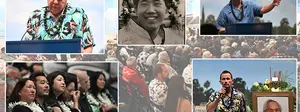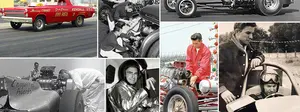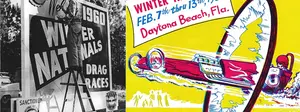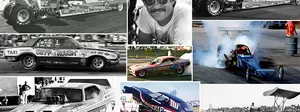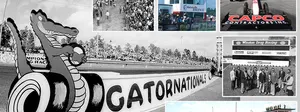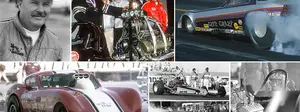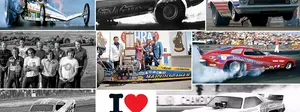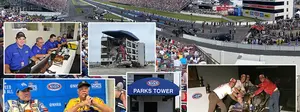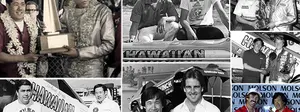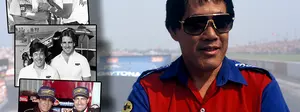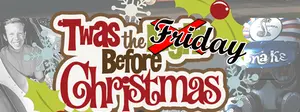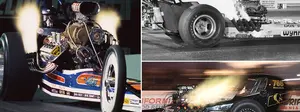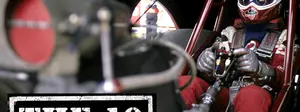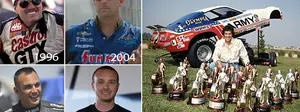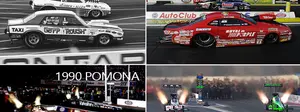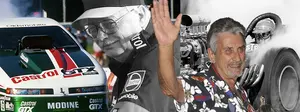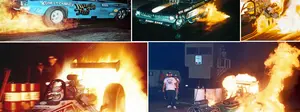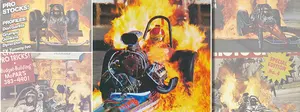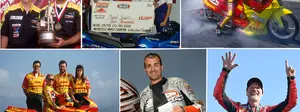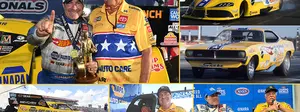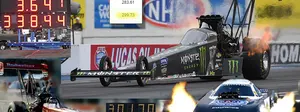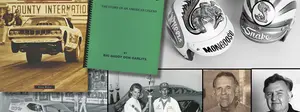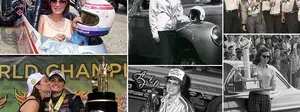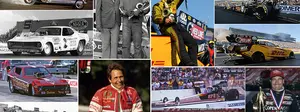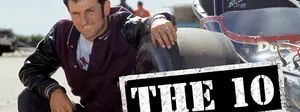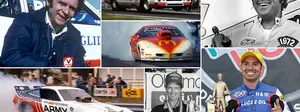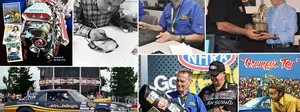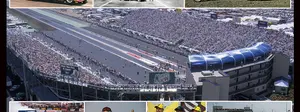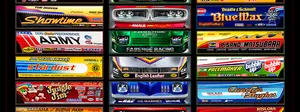On The Road Again, 1970s-style
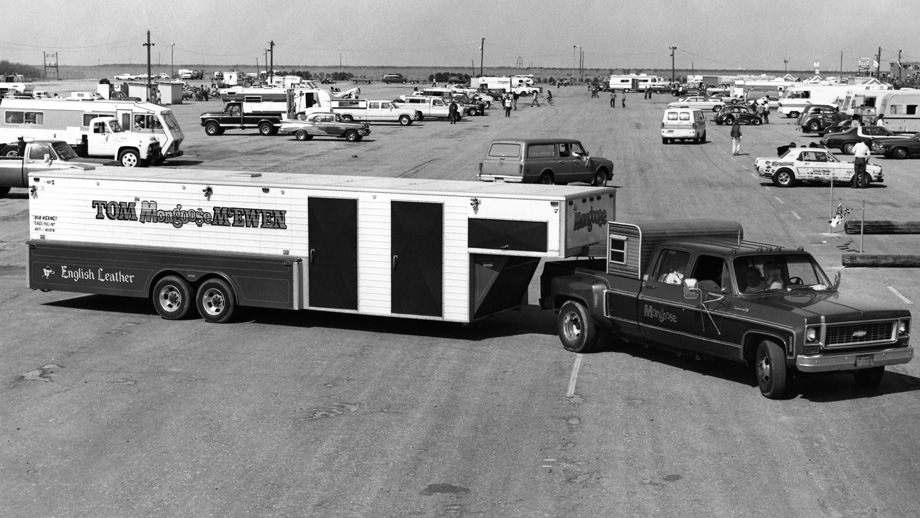
These days, the Western Swing is a pretty big deal, three weeks on the road with no chance to return to home base to restock and regroup. Two weeks ago I was tasked with creating a story for NHRA.com about the Western Swing and all of the parts that are required, which included more than a million dollars in parts alone, let alone the multiple vehicles (support trailers, chase vehicles, etc.)
But, as followers of this column know, life on the never-ending road was a fact of life in the 1970s as teams plied the match-race circuit for weeks and even months on end, stopping just long enough to unload, race, and head out again. That gypsy lifestyle always intrigued me, and I always wanted to learn more about it, so a few years ago I set out to write a definitive piece about those days, which ran in National Dragster. I interviewed a number of the major players and was very proud of it (and still am) and, with the Western Swing ending this weekend, thought I'd share it with you today, with some cool additional photos added.
On the Road Again
Long tows, little sleep, and lots of racing were the order of the day on the 1970s match race trail
 For the better part of two decades, from the mid-1960s to the early 1980s, many drag racers made their fame and fortune by running match races across the country. Guided only by a stack of maps, perhaps some handwritten directions, and an itinerary of appearances to meet, they crisscrossed the nation, racing at tracks of all caliber and description, dealing with sometimes shady promoters, rowdy fans, and always — always — too many miles of highway that had to be gobbled up in too little time with too little sleep.
For the better part of two decades, from the mid-1960s to the early 1980s, many drag racers made their fame and fortune by running match races across the country. Guided only by a stack of maps, perhaps some handwritten directions, and an itinerary of appearances to meet, they crisscrossed the nation, racing at tracks of all caliber and description, dealing with sometimes shady promoters, rowdy fans, and always — always — too many miles of highway that had to be gobbled up in too little time with too little sleep.
Don “the Snake” Prudhomme, Tom “the Mongoose” McEwen, Ed “the Ace” McCulloch, and Roland “the Hawaiian” Leong, four of drag racing’s most famous Top Fuel and Funny Car racers, lived that life and reaped its rewards in both appearance money, publicity, and an ever-growing fan base from sea to shining sea.
There were no GPS units to guide them, no cellphones to call for help while broken down along some lonely and desolate road in the middle of nowhere, and no OnStar to call for aid. They had only themselves and their wits to survive and make it to the next place on their list.
Getting started
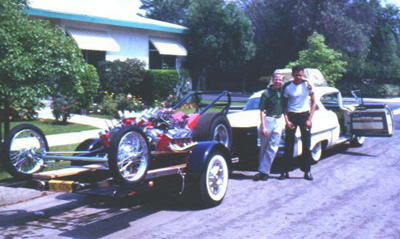
Prudhomme first went on the road when he was 18, serving as the lone crewman on “TV” Tommy Ivo’s dragster in 1960, and the experience he gained helped when he and Leong hit the road in 1965 to capitalize on their Winternationals Top Fuel victory in the Hawaiian.
“I didn’t know anything outside of California existed, but I soon found out there was plenty of action back east and plenty of good racers,” recalled Prudhomme. “Being with Ivo was the first time I saw money exchange hands. I thought, ‘Wow. Can you imagine running a race car and getting paid to do it?’ ”
Prudhomme’s six months on the road with Ivo was all the experience he and Leong had when they decided to tour in 1965.
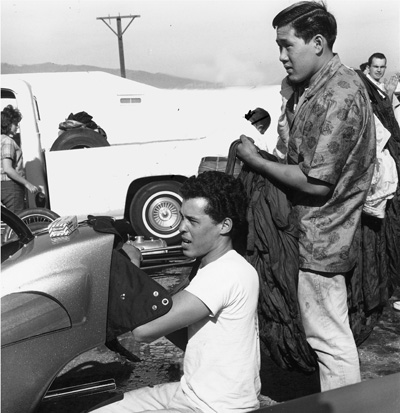 Recalled Leong, “After we won the Winternationals, we raced up and down the West Coast — Fremont [Calif.], Half Moon Bay [Calif.], and Fontana [Calif.] — but then it was, ‘OK, now what are we gonna do?’ I said, ‘Let’s go back east and race with the big guys.’ Prudhomme said, ‘Well, how do we do that?’ I said, ‘I dunno. You were the one who went with Ivo,’ so he booked the car. At the time, we only had an open trailer, so I had to get an enclosed trailer and spare engine and parts. Little did we know that we had just become Professional drag racers.”
Recalled Leong, “After we won the Winternationals, we raced up and down the West Coast — Fremont [Calif.], Half Moon Bay [Calif.], and Fontana [Calif.] — but then it was, ‘OK, now what are we gonna do?’ I said, ‘Let’s go back east and race with the big guys.’ Prudhomme said, ‘Well, how do we do that?’ I said, ‘I dunno. You were the one who went with Ivo,’ so he booked the car. At the time, we only had an open trailer, so I had to get an enclosed trailer and spare engine and parts. Little did we know that we had just become Professional drag racers.”
After Prudhomme and Leong split up at the end of 1965, “the Snake,” wife Lynn, and their Yorkshire Terrier hit the road with the B&M Torkmaster dragster he rented from the Spar brothers, and before long, he and his Southern California buddy “the Mongoose” were running the roads together, first with dragsters and then immortalized together forever as part of the Hot Wheels Funny Car team. Both Leong and McCulloch also jumped on the Funny Car trend, in 1969 and 1970, respectively, and hit the road with fervor.
The booking game
Ideally, a racer would have a whole season booked before leaving home, the fruit of a winter spent working the phones, which rang both ways depending on who you were and what you had accomplished.
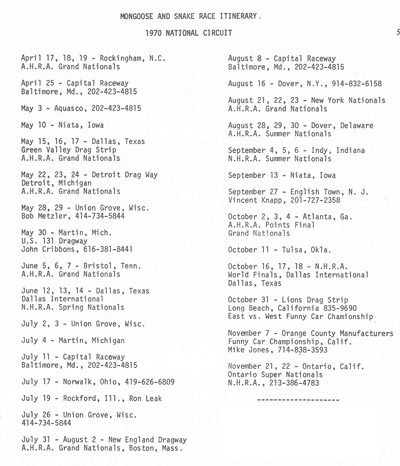
“Winning Pomona was like having a hit record,” recalled Prudhomme. “After that, you could get all kinds of bookings. Tracks would compete against one another to get you; you could raise your prices and make some pretty good money.
“During the winter, you’re on the phone calling about dates and prices, finding out who you’re going to be racing, and after you had a successful outing, a lot of times the track operator would say he’d want you back the same time next year, so by the time you got home for the winter, you were pretty much booked up.”
With the Midwest and East Coast still in thaw, West Coast racers could get an early jump on their seasons before heading east in the spring. Because they were known out west, getting bookings was easy, but in the early days as unknowns, it was tougher back east, even for a guy like McCulloch.
Though best known for his Funny Cars, McCulloch was a Top Fuel racer first — he actually had to be coaxed into a Funny Car to stay in business. Recalled McCulloch, “Jack Coonrod took his A/GS Willys on tour back east and came back and told me, ‘If you’re going to make a living in drag racing, you’ve got to build a Funny Car and go back east.’ At that time, I was a dragster guy who didn’t like Funny Cars, but I built one anyway with Art Whipple.
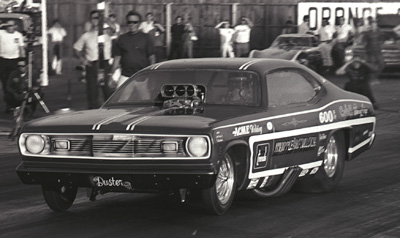 “We set the national record in 1970 at [Orange County Int’l Raceway] [7.19, 211], but nobody had heard of us back east, so we were having a hard time,” he recalled. “The next year, we were at Al Bergler’s shop in Detroit in the summer, and we were struggling to stay afloat and were thinking of heading home. McEwen got on the phone and called some tracks and told them they should give us a shot. If it hadn’t been for him, there’s a very good chance you never would have heard of us. We got some dates, and once they saw what we did and how our car ran, that got us off and running. We went on and did OK, and later that year, we won Indy.”
“We set the national record in 1970 at [Orange County Int’l Raceway] [7.19, 211], but nobody had heard of us back east, so we were having a hard time,” he recalled. “The next year, we were at Al Bergler’s shop in Detroit in the summer, and we were struggling to stay afloat and were thinking of heading home. McEwen got on the phone and called some tracks and told them they should give us a shot. If it hadn’t been for him, there’s a very good chance you never would have heard of us. We got some dates, and once they saw what we did and how our car ran, that got us off and running. We went on and did OK, and later that year, we won Indy.”
Time spent on the road was controlled by the number of bookings one had and what spares were on hand.
“In the early days, we couldn’t carry much on those trailers,” said McEwen. “I don’t think we could even carry a spare short block. All of that changed when we got the Hot Wheels deal. Those ramp trucks allowed us to carry complete spare engines and enough parts to last six months. We had the entire year already booked because once every two or three weeks, we’d stop and display at malls and hold events for the kids. In addition to match races, there also was IHRA or AHRA who would pay us to come run their national events. We were busy.”
The grind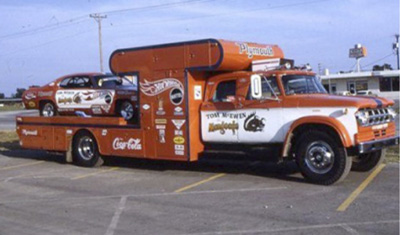 In its heyday, match racing was a four-night-a-week job for some teams, running Wednesday, Friday, Saturday, and Sunday, all at different locations at the behest of track owners and booking agents.
In its heyday, match racing was a four-night-a-week job for some teams, running Wednesday, Friday, Saturday, and Sunday, all at different locations at the behest of track owners and booking agents.
Recalled McEwen, “Ira Litchey [who ran the Chicago-based Gold Agency booking agency] used to call us, and we’d be in Capitol, Md., on a Saturday night, and he’d say, ‘I need you to be in Rockford, Ill., on Sunday.’ I’d say, ‘Are you crazy? That’s 13 hours.’ He’d say, ‘It’s only an inch on the map …’ ”
It wasn’t uncommon for a team to make its last run, load up the car, and hit the road for the next track without a hotel stop or a chance to shower.
“We’d head for a truck stop, try to clean up, and head for the next race,” McEwen continued. “You’re up all night heading 18 hours to the next race, and it’s 3:30 in the morning and you’re tired and greasy and hungry, and you’d see the glow over the next hill, and you’re just praying it’s a Waffle House open 24 hours. That was a big thing for us. It was brutal. Everyone thought that being on the road was so cool, but they never realized the amount of hours and what you had to do to make it work.”
 Recalled Leong, “Sometimes you’d get there and have just enough time to roll the car out of the trailer, check the bearings, and warm ’er up and run first round.”
Recalled Leong, “Sometimes you’d get there and have just enough time to roll the car out of the trailer, check the bearings, and warm ’er up and run first round.”
And getting there was half the fun, finding it sometimes was a whole ’nother story.
“Sometimes the dragstrips were out in the middle of nowhere, in a cornfield somewhere, and you’d have to have the guy meet you in town to show you where it was at,” joked McEwen.
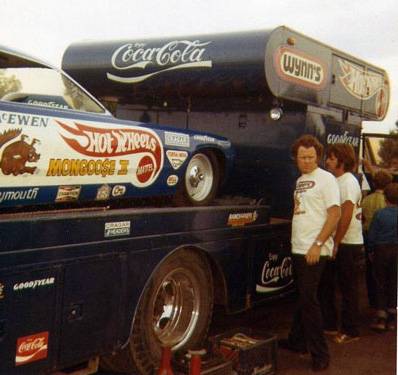 Help was also where you found it, and it was a common occurrence to recruit new help right at the track.
Help was also where you found it, and it was a common occurrence to recruit new help right at the track.
“We couldn’t afford any help, so we’d help each other,” said McEwen. “You could always find someone standing around the pit to help on your car.”
Said Prudhomme, “People would surround your car and help you unload it. You picked up your crew from track to track. I didn’t have any money to pay them, and no one asked. To this day, people still come up to me and say, ‘I helped you pack your chute one time in Union Grove, Wis.,’ or ‘You let me sit in your car.’ That’s a really cool thing people don’t get to experience these days.
“In those early days, sometimes you’d get to a track for the first time and go, ‘Holy [cow]. Guardrails? Forget about it. Safety crews? They came much later. The shutoff area was the main thing that we were concerned about. First thing we always did was go down there and decide where we’d get the chute out or where you could go in case you got in trouble. I always kept a guy down at the other end with a fire extinguisher, and sometimes if we were having troubles with the car, I’d get one of my guys down to wear my spare firesuit in case I needed help getting out.”
“Some of the tracks we ran on were questionable, but we ran them anyway,” added McEwen. “You’d always go down the end of the track and look at it and figure out where you were going to shut off. There’d be a cliff at the end of the track or a river or railroad tracks, or it would be dark, with just a searchlight on the tower behind the track pointed on the track for light, or the fans cars lining the track with their headlights on. We shook our heads a few times, but we were getting paid, and getting paid was a big deal.”
Getting paid
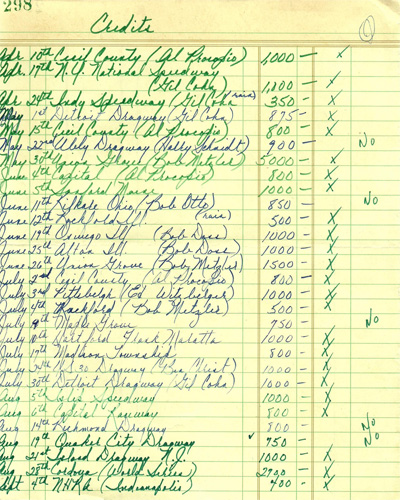
Sometimes the track operator or promoter would pay straight-out appearance money; sometimes it was contingent upon the number of runs made, and sometimes it just didn’t matter.
“It was a game to some of them, trying to cut your money, even though they already had budgeted for you,” said Leong. “It was almost like if you sneezed wrong, they tried to dock your money. My standard line was, ‘You didn’t have to give any of the spectators their money back, so if you didn’t like what I did just give me my money and don’t have me back anymore.’ Usually, though, because I had a good enough name and car I usually came out OK.”
McEwen remembered, “We had some guys where you’d go in to get paid, and he’s got a gun on his hip, patting it, and saying to you, ‘Do you really think you earned your money tonight?’ There was another guy who if you blew up and couldn’t make the required number of runs, he’d want to get under the car with a flashlight, making you show him what broke.”
Said Prudhomme, “Some would cut your pay even if you did a good job so you’d have to go there after your first run and ask for half of your money. There was word that would go around about guys you shouldn’t take a check from, so most of the time, you got cash. We all worked in cash. Detroit Dragway used to have a cinder block building with a guard outside and a guard inside where they’d be counting the cash. They all had guns, not so much because of us, but because they were worried about getting robbed.
“The first big money I ever made was in 1966 at [the track in] Union Grove. They were paying $1,000 to win each day, plus another $1,000 if you won both, which I did. I left there with $3,300, which was a lot of money in those days, then stayed awake all night, looking out through the blinds of the window in my hotel room because I thought someone was going to rob me.”
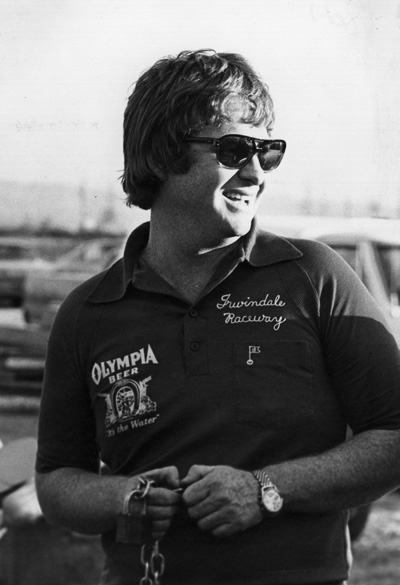 “There were some really good guys, and there were shady guys,” McCulloch assessed. “I ran for Bill Doner [pictured right] a lot, and he’d play hardball sometimes, but he was fair and level with you. He might get weather or have a bad crowd, and he’d say, ‘Ace, I really took a bath here. If you could help me out on this one, I’d make it up to you at the next one,’ and he always would. Whatever we were short, he’d take care of it with a little extra. For the most part, though, guys would sometimes try to cut you down, but they generally ended up paying you what you were promised.”
“There were some really good guys, and there were shady guys,” McCulloch assessed. “I ran for Bill Doner [pictured right] a lot, and he’d play hardball sometimes, but he was fair and level with you. He might get weather or have a bad crowd, and he’d say, ‘Ace, I really took a bath here. If you could help me out on this one, I’d make it up to you at the next one,’ and he always would. Whatever we were short, he’d take care of it with a little extra. For the most part, though, guys would sometimes try to cut you down, but they generally ended up paying you what you were promised.”
And match race payouts also helped fund championship runs at national events.
“The only way you could afford to run a national event was to do the match races because it cost so much, and you only made money on how well you did,” said Prudhomme. “But track operators would get mad at us because we’d run national events where we weren’t getting paid. ‘Why would we want to pay you to race when you’ll go over there and run for nothing?’ they’d say.
Sometimes, getting paid wasn’t their only concern at the races.
“At some tracks, there was gambling in the bleachers,” recalled McEwen. “They would just bet on who got to the finish line first; red-lights, crossing the centerline, none of that mattered. Some of those guys were very serious about that. If you lost, they’d come by and ask you what happened. ‘Well, I broke the rear end.’ They’d say, ‘Let me see it.’ It was bad.”
Tales of the road 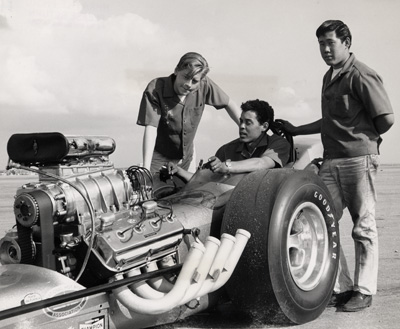 “When Roland and I toured in 1965, we had this enclosed trailer made of wood, like Noah’s Ark,” Prudhomme reminisced. “It was heavy because no one knew about building trailers back then. We were forever blowing out tires because we were overweight; it was all trial and error. It was an ill-handling son of a bitch. I wouldn’t let him drive, but I got so tired one time somewhere in the middle of Oklahoma and let him drive. When I woke up, he was in the left-hand lane passing a truck. He said, ‘Hey, Vipe, I think I got this driving thing down now.’ Just when he said that, he got sucked into the truck, lost it, and spun us out. Neither of us got hurt, but we ended up in the middle of the highway with stuff all spread out and messed up and had to be towed to Jimmy Nix’s place.”
“When Roland and I toured in 1965, we had this enclosed trailer made of wood, like Noah’s Ark,” Prudhomme reminisced. “It was heavy because no one knew about building trailers back then. We were forever blowing out tires because we were overweight; it was all trial and error. It was an ill-handling son of a bitch. I wouldn’t let him drive, but I got so tired one time somewhere in the middle of Oklahoma and let him drive. When I woke up, he was in the left-hand lane passing a truck. He said, ‘Hey, Vipe, I think I got this driving thing down now.’ Just when he said that, he got sucked into the truck, lost it, and spun us out. Neither of us got hurt, but we ended up in the middle of the highway with stuff all spread out and messed up and had to be towed to Jimmy Nix’s place.”
Things got worse for Leong the next year, with new driver Mike Snively, on their way from California to Amarillo, Texas. Leong was asleep in the back of their station wagon when another racer, driving a ’57 Chevy and pulling another ’57 Chevy, tried to pass them on a two-lane road and lost control and swerved back into them, sending both rigs off the road and upside down.
“I woke up, and I heard all of this banging. I didn’t know what was happening; I thought I was dreaming,” said Leong. “It was pitch black out. No one was hurt, but we couldn’t find our trailer. It had broken off and ended up in the desert a quarter-mile away. It totaled the wagon, and I had to front half the car, but we ended up winning Indy later that year.”
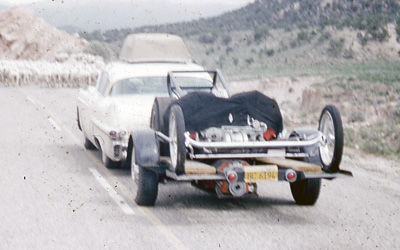 “My first tow car was my mother’s ’58 Thunderbird, and I was towing an unsprung steel trailer,” McEwen recalled. “We had those big steel engines in our flimsy little dragsters, and every time I reached a town, I’d have to find a blacksmith shop to reweld the cheap cold-rolled tubing on the dragster because that big engine was breaking all of the welds on the frame. Everything was crude; we were learning the hard way.”
“My first tow car was my mother’s ’58 Thunderbird, and I was towing an unsprung steel trailer,” McEwen recalled. “We had those big steel engines in our flimsy little dragsters, and every time I reached a town, I’d have to find a blacksmith shop to reweld the cheap cold-rolled tubing on the dragster because that big engine was breaking all of the welds on the frame. Everything was crude; we were learning the hard way.”
“We had a lot of tire trouble with the trailers,” McCulloch agreed. “You’d blow a tire and put on the spare, then blow another one, but you’re out of spares, but we quickly learned that you could jack it up, lock the suspension, and run it down the road on three wheels.
“The crew guys today run a lot of miles down the road, but people don’t understand the lengths we had to go to on the road to make the next date. We would drive all night, race, drive all night, race, drive all night, race. Today, they drive a long ways, but they’re there for a week before they have to hit the road again.

“One time Bernie Wadekamper and I were going from Portland [Ore.] up to Calgary [Alta.] in our Chevy duallie,” added McCulloch. “It was the middle of the night somewhere in Idaho, and the truck started running terrible; it needed a valve job. You take it to the dealership to get something like that done, you know it would be there for a week, so we limped it into Couer d’Alene [Idaho] and pulled up to the front of an automotive machine shop at 3 or 4 in the morning. We unloaded our generator and our little air compressor and our droplight and pulled the heads off right there. When the guys got there at 8 o’clock to open up, we handed them the heads, had them do a valve job, bought the gasket kit from them, hammered it back together, and went off down the road.
“Another time we broke the harmonic balancer. We put another one and welded it to the crankshaft, but it had a wobble in it and would break the lower pulley. We only had one pulley and could only run one belt, so we chose the water pump, which meant we had no lights because it would drain the battery [without a working alternator]. So it was nighttime, and we’re running down the highway behind Danny Ongais, who had a ramp truck with the [Vel’s Parnelli Jones racing team] car, and Raymond Beadle was right behind us. We were going 65 to 70 mph with no lights, just motoring down the road, getting after it until we could find a place to fix the thing.
“Sometimes we would travel together like that, but we could always make better time on our own. You might want to stop and go to the bathroom, but they don’t need to, then you’d get back on the road and get 10 miles down the road, they have to stop, but certainly if you saw one of the guys pulled over and broken down, you’d stop and lend a hand.”
Battle scars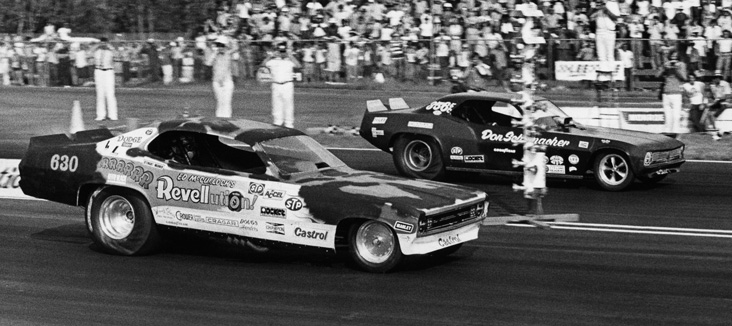
The Funny Car final at the 1972 Summernationals pitted two of the ugliest cars you can imagine: The beat-up machines of Don Schumacher and McCulloch, covered in primer and looking more than worse for the wear as the result of the match race grind. It’s a wonder McCulloch was there at all.
 “We had run a match race there at Englishtown before the national event, and I had blown the body off,” McCulloch recalled. “It was a mistake on my part. It was just my brother, Dan, and I working on the car, and he stripped the bolt on the clamp that held the coupler on. I was up top, changing the down nozzles [for the fuel system], so I crawled under to help him and forgot about the nozzle bodies not being tightened. We fired it up, and at idle, it was OK. When I did the burnout, there was a spray of fuel. I thought, ‘Hmmmm,’ but went ahead and staged and ran. It went about 30 feet, and it knocked the blower off, and the body went skyward in pieces.
“We had run a match race there at Englishtown before the national event, and I had blown the body off,” McCulloch recalled. “It was a mistake on my part. It was just my brother, Dan, and I working on the car, and he stripped the bolt on the clamp that held the coupler on. I was up top, changing the down nozzles [for the fuel system], so I crawled under to help him and forgot about the nozzle bodies not being tightened. We fired it up, and at idle, it was OK. When I did the burnout, there was a spray of fuel. I thought, ‘Hmmmm,’ but went ahead and staged and ran. It went about 30 feet, and it knocked the blower off, and the body went skyward in pieces.
“Everyone told me we could fix it, but I told the guys I was burned out and was heading home. I loaded up and headed down the road. I got to about Philadelphia and changed my mind. I drove late into the night headed to Kenny Hirata’s shop in Lowell, Ind. I called him the next morning and told him, ‘Kenny, I have some body work to do, and we have to replace some tin.’ He said, ‘Bring it on.’ I pulled in there, and when we dropped the trailer door and started carrying out pieces of the body, Kenny said, ‘I thought you had a little body work to do.’ To make a long story short, we got it patched up and glued back together and primered and headed back to Englishtown. That was just what you did in those days.”
Doing it differently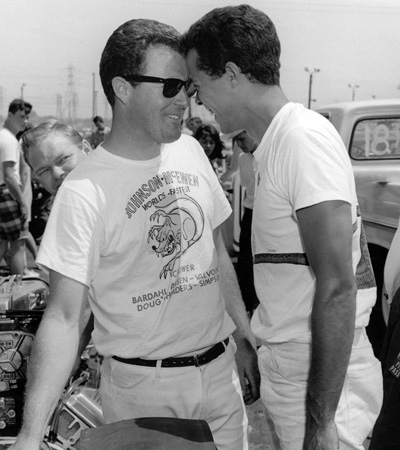 Prudhomme and McEwen were like night and day in their approach to racing, but somehow they made it work.
Prudhomme and McEwen were like night and day in their approach to racing, but somehow they made it work.
“He was laid back. I was possessed,” said Prudhomme. “Thank God we both weren’t like me, or we would have driven each other nuts or been in each other’s face all the time.”
“There were times he’d get on me because he didn’t think I was serious enough,” admitted McEwen. “There were times like that I think he wasn’t happy with me. I told him I liked racing, but there were other things I liked, too, like meeting new people, wine, women, and song.
“But if I had a race car back in the day and wanted to hire a driver who was really good when it counted, someone who would step up against the best guys or at a national event, I don’t think anyone was better than me,” he added. “But racing against the average guy, I didn’t do it like Prudhomme, who wanted to tear their heart out against anyone they raced. Me, I just wanted to go out there, drive, have fun, and go on down the road.”
Last year during an appearance in Las Vegas, they reminisced about a hot summer night in Texas.

“As he tells it, I was in the motel with a blonde, and he was out in the parking lot at 3 o’clock in the morning honing his engine,” said McEwen. “I opened the door and asked him if he could keep the noise down a little bit.”
Prudhomme’s retort. “Guess who won that night.”
“I raced Prudhomme a lot; I didn’t beat him a lot because he was almost always faster, but when I did, it was usually because I left on him,” said McEwen. “He’d get pissed off at me and wouldn’t talk to me. When it came to racing, winning was No. 1, and everything else was No. 2. We got along as best we could, and we were still buddies, but I’d have to bite my tongue sometimes because we didn’t want to split up the Wildfire Racing deal."
The best of times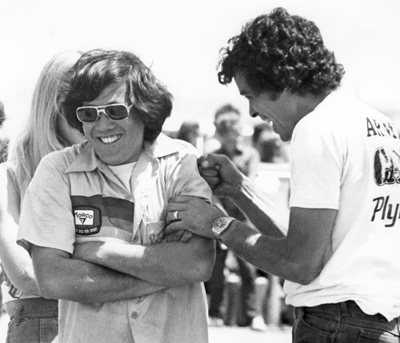 For all the long hours behind the wheel, the breakdowns, the relentless grind of the match race trail, all will never forget it and treasure those carefree days of their youth.
For all the long hours behind the wheel, the breakdowns, the relentless grind of the match race trail, all will never forget it and treasure those carefree days of their youth.
“It was an experience; for the age we were, it was a helluva experience,” said Leong. “We saw a lot of the country, and after we’d been on the road for so long, we got to know people in almost every town, and we’d do something with them whether it was to go to their house for dinner or go out and do things with them. For me, it was the experience of a lifetime.”
“It was more than just a fun time,” agreed Prudhomme. “It was the best.”
Phil Burgess can be reached at pburgess@nhra.com


